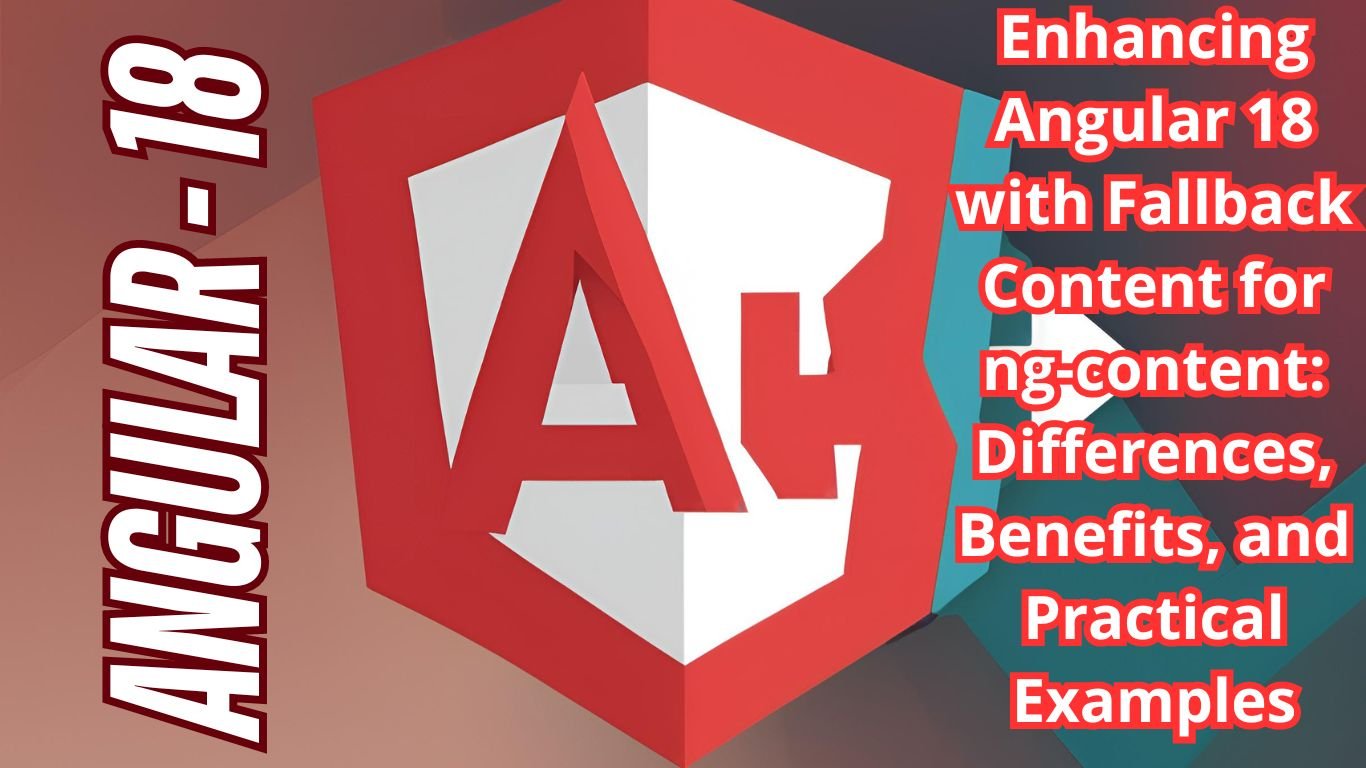Overview of Angular 18 – Fallback Content for ng-content
Welcome to Blogs Overflow: Empowering Knowledge by Overflow Orbits Private Limited. Angular 18 ng-content Fallback: Differences, Benefits, and Examples
Angular 18 introduces fallback content for ng-content, allowing developers to define default content if no content is provided by the parent component. This feature enhances the flexibility and robustness of Angular applications by ensuring that components display meaningful content even when no projection is available.
Parent Article: “Angular 18: Top New Features, Enhancements, and Benefits for Developers“
Purpose of Angular 18 ng-content fallback
The primary purpose of fallback content for ng-content is to improve user experience by displaying default content when a slot is empty. This ensures that components are always functional and visually complete, regardless of the parent component’s content projection.
Key Differences from Previous Versions
- Content Projection:
- Before Angular 18:
ng-contentwould be empty if no content was provided by the parent component. - Angular 18: Allows defining fallback content directly within the component, ensuring default content is displayed if the parent does not provide any.
- Implementation Complexity:
- Before Angular 18: Developers had to manually handle empty content scenarios using conditionals and additional logic.
- Angular 18: Simplifies this process by allowing fallback content to be declared directly within the template.
Use Cases for Fallback Content
- Reusable Components:
- Ensures that reusable components always display meaningful content, even when no specific content is projected.
- Library Components:
- Enhances component libraries by providing default content, making components more intuitive and ready to use out of the box.
- Dynamic Content:
- Ideal for scenarios where content might be dynamically generated or fetched, providing a better user experience during loading or when data is unavailable.
Advantages of Fallback Content for ng-content
- Improved User Experience:
- Guarantees that components always display something meaningful, improving the overall user experience.
- Simplified Code:
- Reduces the need for additional logic to handle empty content slots, simplifying the component code.
- Enhanced Reusability:
- Makes components more robust and reusable by ensuring they are functional without relying on parent-provided content.
Drawbacks of Fallback Content for ng-content
- Increased Template Size:
- Adding fallback content might increase the size of component templates, potentially affecting performance.
- Overhead for Static Content:
- In scenarios where content is always provided, defining fallback content might introduce unnecessary overhead.
Comparison Metrics
| Metric | Before Angular 18 | Angular 18 |
|---|---|---|
| Content Projection | Empty if no content provided | Displays fallback content |
| Implementation Complexity | High, requires additional logic | Simplified, declarative approach |
| User Experience | Variable, dependent on parent content | Consistent, always displays meaningful content |
| Template Size | Smaller, no fallback content | Larger, includes fallback content |
| Code Maintenance | More complex, additional conditional logic | Easier, declarative fallback handling |
Code Example
Before Angular 18
example.component.html
<div *ngIf="hasContent; else fallback">
<ng-content></ng-content>
</div>
<ng-template #fallback>
<p>Default fallback content.</p>
</ng-template>example.component.ts
import { Component, AfterContentInit, ContentChild, TemplateRef } from '@angular/core';
@Component({
selector: 'app-example',
templateUrl: './example.component.html',
styleUrls: ['./example.component.css']
})
export class ExampleComponent implements AfterContentInit {
hasContent = false;
@ContentChild(TemplateRef, {static: true}) content: TemplateRef<any>;
ngAfterContentInit() {
this.hasContent = !!this.content;
}
}Angular 18 Standalone Component
example.component.html
<div>
<ng-content select="[slot]"></ng-content>
<div *ngIf="!hasProjectedContent">
<p>Default fallback content.</p>
</div>
</div>example.component.ts
import { Component, AfterContentInit, ContentChildren, QueryList } from '@angular/core';
@Component({
selector: 'app-example',
templateUrl: './example.component.html',
styleUrls: ['./example.component.css'],
standalone: true
})
export class ExampleComponent implements AfterContentInit {
hasProjectedContent = false;
@ContentChildren('slot', {descendants: true}) content: QueryList<any>;
ngAfterContentInit() {
this.hasProjectedContent = this.content && this.content.length > 0;
}
}Explanation of Angular 18 Code
- Template (example.component.html):
<ng-content select="[slot]"></ng-content>: This line projects content that matches theslotattribute from the parent component.<div *ngIf="!hasProjectedContent">: If no content is projected, this div will be displayed, showing the fallback content.
- Component Class (example.component.ts):
@ContentChildren('slot', {descendants: true}): This decorator is used to query for elements marked with theslotattribute.ngAfterContentInit(): This lifecycle hook checks if any content was projected. If not, it setshasProjectedContenttofalse, triggering the fallback content.
Conclusion
Angular 18’s fallback content for ng-content simplifies the process of ensuring meaningful default content is displayed in components. This feature enhances user experience and simplifies component code by eliminating the need for additional conditional logic. By understanding the key differences, use cases, advantages, and potential drawbacks, developers can effectively leverage this feature to create more robust and user-friendly Angular applications.











1 thought on “Enhancing Angular 18 with Fallback Content for ng-content: Differences, Benefits, and Practical Examples”